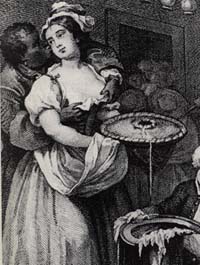 |
William Hogarth, A Committee of the House of
Commons ( 75) |
|
| The representation
of blacks in English art most commonly emphasized a role of subservience.
William Hogarth's A Committee of the House of Commons (left)
depicts one black man amongst a crowd of established white men. The
delineation of power is obvious: all of the members of Parliament
are standing or sitting in a liesurely manner while the sole black
man depicted is carrying a heavy burden on his shoulders. |
| There are
two possible interpretations of this scene. One is a commentary on
the pretentiousness of the powerful white man, who allows others to
do his work for him. The other is an endorsement of race and class
stratification: white males deserve their positions of power while
black males deserve only a miserly station. Though Hogarth used his
art to criticize the upper-class (76),
the manner in which the black man is depicted in this work is similar
to those artists who portrayed blacks as inferior. |
|
| Black
inferiority was often represented through animalistic characteristics.
As described in the religious debate,
blacks were not considered human beings by many people, but rather,
as beasts. |
| Rowlandson's
Broad Grins (right) is an excellent example of this mentality.
The facial similarities between the alligator and the black man are
striking. Both have very wide, round eyes. The man has a long nose,
and long, sharp teeth that are visible through his gaping mouth. The
alligator also possesses these features. This sort of depiction helped
justify the argument that blacks were not human, a common argument
in the 18th century. |
|
|
|
Rowlandson, Broad Grins ( 77) |
|
|
|
Hogarth, Four Times of Day- Noon ( 79) |
|
| Another
common belief during the 18th century was that blacks were savage
and dangerous. For example, some women believed that "Africans
needed to live in English society because it was civilized" (78),
which implied that blacks were savages. |
| Artwork
reflected this mentality and acted as a means to keep blacks in bondage.
Hogarth's Four Times of Day-Noon (left) shows a potentially
dangerous scene. The black man is groping the white female in public.
Open sexual advances were considered crude and even dangerous. The
fact that a black man is touching a white woman would be even more
dangerous since it not only defies sexual norms, but it also crosses
the racial divide. Although Hogarth is satirizing the lower-class
in this work, his representation of the black man still reflects common
misconceptions of the 18th century. |
|
| One other
way blacks were depicted in English art was as the "poster boy"
for the products that they produced. Marshall's Tobacco Tradecard
(right) shows a black man smoking a pipe, and is described in the
caption as a "blackamoor." This has a few implications. |
| The first
is that the black man uses the product that he produced. If a slave
enjoys the fruit of his own labor, then his bondage is justified.
This is a clever strategy on the part of the tobacconist since he
sells a product that was boycotted by abolitionists in England. |
| The other
is that the black man is a Moor. By depicting the black man as such,
the artist creates aversion toward blacks, since Moors were Muslim
and the English were almost entirely Christian. Both of these representations
helped justify using slavery to grow a popular (and profitable crop)
in the British empire. |
|
 |
Anonymous, Marshalls Tobacco Tradecard ( 80) |
|




